


 |
Flagg is in #s 2 & 5 of |
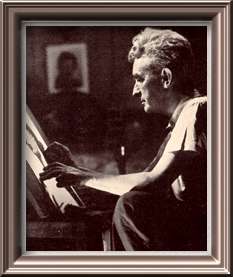 James Montgomery Flagg was an early
master of pen and ink, but he was much more. Born in 1877, he
grew up along with the reproduction technology that allowed artists
to select the pen as the illustrative tool of choice. Charles
Dana Gibson, who pioneered many of the techniques that Flagg would
draw upon, was ten years older. Others born within a year of Flagg
include Stanley M. Arthurs, Ivan Bilibin, Walter
Appleton Clark, Fanny Y. Cory, Frank Leyendecker, Norman Price, Harry Rountree, Frank Schoonover, Everett Shinn, J. Allen St. John, Sarah Stilwell, and J. Scott
Williams.
James Montgomery Flagg was an early
master of pen and ink, but he was much more. Born in 1877, he
grew up along with the reproduction technology that allowed artists
to select the pen as the illustrative tool of choice. Charles
Dana Gibson, who pioneered many of the techniques that Flagg would
draw upon, was ten years older. Others born within a year of Flagg
include Stanley M. Arthurs, Ivan Bilibin, Walter
Appleton Clark, Fanny Y. Cory, Frank Leyendecker, Norman Price, Harry Rountree, Frank Schoonover, Everett Shinn, J. Allen St. John, Sarah Stilwell, and J. Scott
Williams.
A true child prodigy, Flagg sold his first illustration, to the prestigious St. Nicholas Magazine no less, at the age of twelve. You can read about his early encounters with the editor in a 1915 article in The Century.
This early sale proved not to be a fluke. By the age of 15 he was on staff at both Life and Judge, the premier humor magazines of the day. Below left is an 1894 illustration from Life. Below right is an early drawing from Judge, probably circa 1905.
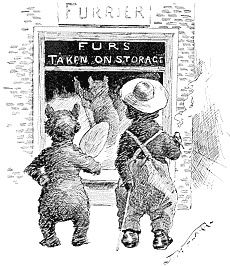 |
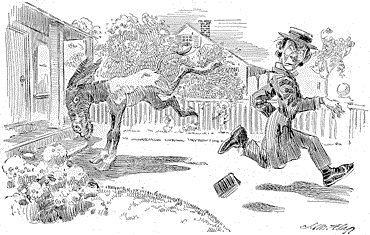 |
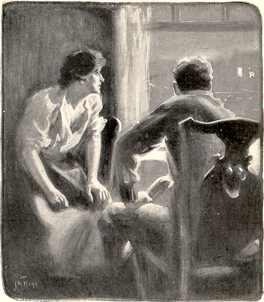 It's kind of hard to imagine today,
but the teenage Flagg grew up in the company of some of the most
respected magazine editors of the day. Drawing was his passion
and the traditional pastimes of youth were of no interest to him.
Although he spent several years in art schools, most notably the
Art Students League (1894-1898), his real education
came from the material that passed over the desks of the editors
of St. Nicholas, Judge and Life. These he
was allowed to study and the lessons he learned from them were
more valuable than all of his schooling. Those same publishers
made use of the young Flagg for his earliest magazine covers are
from 1895 and '96.
It's kind of hard to imagine today,
but the teenage Flagg grew up in the company of some of the most
respected magazine editors of the day. Drawing was his passion
and the traditional pastimes of youth were of no interest to him.
Although he spent several years in art schools, most notably the
Art Students League (1894-1898), his real education
came from the material that passed over the desks of the editors
of St. Nicholas, Judge and Life. These he
was allowed to study and the lessons he learned from them were
more valuable than all of his schooling. Those same publishers
made use of the young Flagg for his earliest magazine covers are
from 1895 and '96.
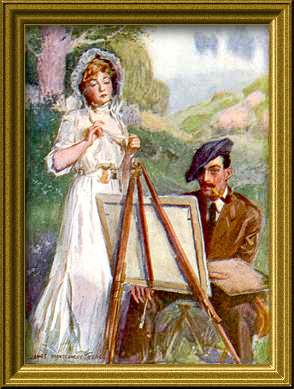 From 1898-1900 Flagg studied painting
in England and France. His first book was Yankee Girls Abroad
(1900). That same year he had a portrait accepted to the Paris
Salon, but he felt that painting was not his forte and returned
to illustration. Above left is an image from the January 1902
issue of Harper's Monthly - perhaps the only work he did
for the magazine.
From 1898-1900 Flagg studied painting
in England and France. His first book was Yankee Girls Abroad
(1900). That same year he had a portrait accepted to the Paris
Salon, but he felt that painting was not his forte and returned
to illustration. Above left is an image from the January 1902
issue of Harper's Monthly - perhaps the only work he did
for the magazine.
Most of the early years of the century were still spent at Judge and Life and Harper's Weekly - Life released four collections of his "limericks" (just clever poems, really) in 1904. By 1905 he began to illustrate books again. At right is one of the plates from An Orchard Princess from that year. These early efforts were mainly paintings, despite his focus on pen & ink at the humor magazines. It wasn't until about 1906 that his recognizable pen style appears in his book illustrations. A good example is show below from Simon the Jester (1909).
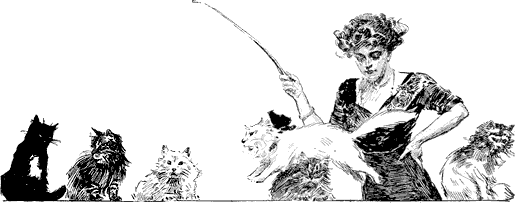
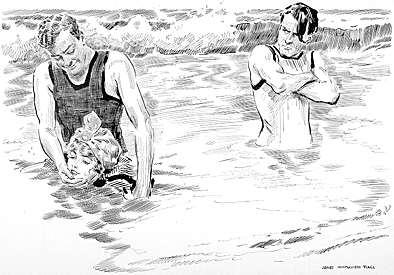
 A collection
of his large drawings for Harper's Weekly saw print as
City People in 1909. The Adventures of Kitty Cobb
was published in 1912.This large book (12"x12") was
a series of plates with a paragraph of text below each. Throughout
the teens and early 20's, Flagg's book illustration output was
prodigious. I have 35 titles alone from 1908 to 1925, and that
doesn't count his numerous magazine appearances- like the 1911
Life cover at right.
A collection
of his large drawings for Harper's Weekly saw print as
City People in 1909. The Adventures of Kitty Cobb
was published in 1912.This large book (12"x12") was
a series of plates with a paragraph of text below each. Throughout
the teens and early 20's, Flagg's book illustration output was
prodigious. I have 35 titles alone from 1908 to 1925, and that
doesn't count his numerous magazine appearances- like the 1911
Life cover at right.
Flagg was a rakish fellow whose cocky self-assurance served him well in the highly competitive illustration markets. Stories abound of his deeds and misdeeds. Susan E. Meyer in her excellent James Montgomery Flagg relates how he persevered in his attempts to break into the Scribner's Magazine market. He was finally, so the story goes, asked to tackle an assignment that had stumped three other artists. Flagg supposedly solved the problems of this difficult Voodoo storyline and became a regular contributor.
All well and good, except I've checked all the Scribner's from 1904 through 1907, when he is an established contributor to the magazine, and there doesn't seem to be any JMF Voodoo story. In fact, his first appearances in 1906 are rather pedestrian. But it makes a great story...
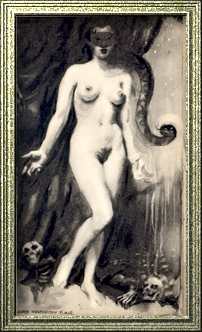 Flagg was outspoken and lived a
bohemian style of life. Despite a marriage that lasted from 1899
until his wife's death in 1923, he was known for his cavorting
around town with pals like John Barrymore. He was close friends
with many of his contemporaries: Arthur William Brown, Walter Appleton Clark, Ham Fisher, Rube Goldberg,
etc. Flagg was a founder member of the infamous Dutch Treat Club
in 1906 (its president in 1913), a loose association of creative
types that turned into an organization still going strong today.
Flagg was outspoken and lived a
bohemian style of life. Despite a marriage that lasted from 1899
until his wife's death in 1923, he was known for his cavorting
around town with pals like John Barrymore. He was close friends
with many of his contemporaries: Arthur William Brown, Walter Appleton Clark, Ham Fisher, Rube Goldberg,
etc. Flagg was a founder member of the infamous Dutch Treat Club
in 1906 (its president in 1913), a loose association of creative
types that turned into an organization still going strong today.
He wrote the first of their annual productions and was elected an honorary life member in 1926. By then he had dropped out of active participation, but when the Depression hit and the club loosened up, he was back. He began to contribute artwork to the wonderful annuals that were distributed at the yearly dinners. At right is one from 1935. It seems that the more bawdy and risque and boisterous the organization became, the more Monty wanted to be a part of it. The ribaldry reached its zenith in the early years of WWII. As the rest of the world loosened up, the naughtiness wasn't quite as much fun I guess. By 1950, the annual books were less daring. While they still had a few gorgeous drawings and paintings by the likes of Bradshaw Crandell, Monty Flagg was no longer participating.

 He was
a member of the Society of Illustrators (his portrait of friend
Charles Dana Gibson at right appeared in the 1911 SofI Annual),
the Lotos Club, the Players Club and the Artists and Writers Club.
And he was both. He wrote for Life and Judge, and
even wrote and acted in silent films. These were so well received
that during World War One he was asked to write promotional films
for the Marines and for the Red Cross. It was also during WWI
that his famous painting of Uncle Sam pointing at the viewer with
the caption "I Want YOU for U.S. Army" was published.
He created 45 other patriotic posters for the war effort including
the powerful "Wake Up America Day" at left.
After the war, it was the magazines of America that were his
showroom. Nearly every major publisher featured his art at one
time or another. In (very) rough chronological sequence he was
in Photoplay, McClures, Cosmopolitan, The
Saturday Evening Post, Redbook, Hearst's International,
Liberty, Colliers, Women's Home Companion, Ladies
Home Journal, The American Weekly and many others.
He drew caricatures of movie stars for Photoplay until
1950. A collection of some of these drawings was released as Celebrities in 1951.
He was
a member of the Society of Illustrators (his portrait of friend
Charles Dana Gibson at right appeared in the 1911 SofI Annual),
the Lotos Club, the Players Club and the Artists and Writers Club.
And he was both. He wrote for Life and Judge, and
even wrote and acted in silent films. These were so well received
that during World War One he was asked to write promotional films
for the Marines and for the Red Cross. It was also during WWI
that his famous painting of Uncle Sam pointing at the viewer with
the caption "I Want YOU for U.S. Army" was published.
He created 45 other patriotic posters for the war effort including
the powerful "Wake Up America Day" at left.
After the war, it was the magazines of America that were his
showroom. Nearly every major publisher featured his art at one
time or another. In (very) rough chronological sequence he was
in Photoplay, McClures, Cosmopolitan, The
Saturday Evening Post, Redbook, Hearst's International,
Liberty, Colliers, Women's Home Companion, Ladies
Home Journal, The American Weekly and many others.
He drew caricatures of movie stars for Photoplay until
1950. A collection of some of these drawings was released as Celebrities in 1951. A few books were sprinkled amongst
the magazines. There was the riotous Virgins in Cellophane
in 1932 and his autobiography, Roses and Buckshot in 1946.
The dust jacket for the 1934 P.G. Wodehouse offering, at right,
may have been an illustration for the story's initial appearance
in The Saturday Evening Post. Flagg did illustrations for
many of the Jeeves novels as they were serialized. He did numerous
drawings for the Cosmopolitan serialization of Thank
You, Jeeves, also in 1934 and several other titles in Colliers
- it seems that Wodehouse got around almost as much as Flagg.
A few books were sprinkled amongst
the magazines. There was the riotous Virgins in Cellophane
in 1932 and his autobiography, Roses and Buckshot in 1946.
The dust jacket for the 1934 P.G. Wodehouse offering, at right,
may have been an illustration for the story's initial appearance
in The Saturday Evening Post. Flagg did illustrations for
many of the Jeeves novels as they were serialized. He did numerous
drawings for the Cosmopolitan serialization of Thank
You, Jeeves, also in 1934 and several other titles in Colliers
- it seems that Wodehouse got around almost as much as Flagg.

When he wasn't illustrating or drawing caricatures or painting portraits, he would paint for himself. He was an artist and felt that it was in the blood, not taught in a school. He dismissed his schooling as wasted time. Indeed, he was working professionally throughout the entire process. He was outspoken and frank. His friends loved him for it and it served to keep away those who didn't. Click here for an intimate remembrance from 1937 by Willis Birchman.
When he died in 1960, the members of the service included Dean Cornwell, Jack Dempsey, Everett Raymond Kinstler, Arthur William Brown and many other friends of long-standing.
He was elected to the Society of Illustrators Hall of Fame in 1980.
 To learn more about James Montgomery Flagg, see:
To learn more about James Montgomery Flagg, see:| Faces and Facts About 26 Contemporary Artists | Willis Birchman, 1937 |
| James Montgomery Flagg | Susan E. Meyer, Watson-Guptill 1974 |
| Illustrators 22 | Terry Brown, Society of Illustrators 1981 |
| The Illustrator in America 1880 to 1980 | Walt and Roger Reed, Madison Square Press 1984 |
| Famous American Illustrators | Arpi Ermoyan, Rotovision, 1997 |
| The Vadeboncoeur Collection of Knowledge | Jim Vadeboncoeur, Jr. 2001 |
| The Vadeboncoeur Collection of B&W ImageS 2,5 | Jim Vadeboncoeur, Jr. 2004, 2010, JVJ Publishing |
|
Illustrations are copyright
by their respective owners. This page written, designed & © 2001 by Jim Vadeboncoeur, Jr. Updated 2011. |
